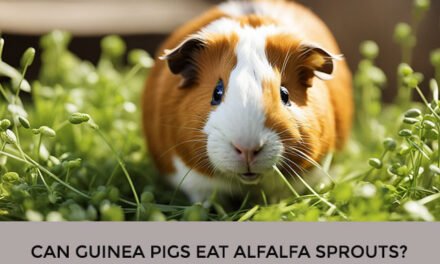Guinea pigs are adorable and friendly pets that require a balanced diet to maintain their health. As a responsible pet owner, you may wonder if mint leaves are safe for your guinea pig to eat. The answer is yes, guinea pigs can eat mint leaves, but there are some precautions to keep in mind.
Mint leaves are a good source of vitamins and minerals that are essential for your guinea pig’s well-being. They contain vitamin C, which is crucial for their immune system, and calcium, which helps to keep their bones strong. However, it’s important to note that mint leaves should only be given to your guinea pig in moderation and as a treat. Overfeeding mint leaves can cause digestive problems such as diarrhea, bloating, and gas.
It’s also important to ensure that the mint leaves you give to your guinea pig are fresh and free of pesticides or other harmful chemicals. You can grow mint leaves in your garden or purchase them from a trusted source. Additionally, you can mix mint leaves with other safe vegetables and fruits to provide your guinea pig with a varied and nutritious diet.
Nutritional Profile of Mint Leaves
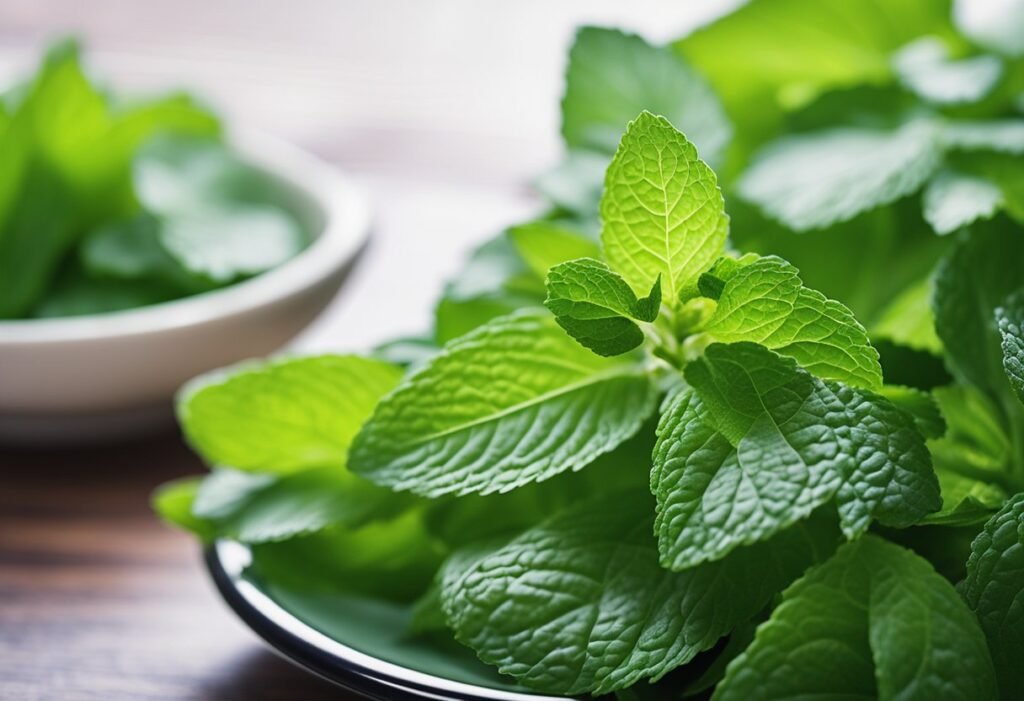
Mint leaves are a flavorful herb that can be used in a variety of dishes and beverages. They are also a popular ingredient in teas, candies, and chewing gums. But what is the nutritional profile of mint leaves? Let’s take a closer look.
Macronutrients
Mint leaves are low in calories and carbohydrates, making them a great addition to a healthy diet. One cup of chopped mint leaves contains approximately:
- 12 calories
- 2 grams of carbohydrates
- 1 gram of protein
- 0 grams of fat
Vitamins and Minerals
Mint leaves are a good source of several vitamins and minerals, including:
- Vitamin C: One cup of chopped mint leaves contains approximately 8% of the recommended daily intake of vitamin C.
- Vitamin A: Mint leaves are rich in vitamin A, with one cup providing approximately 24% of the recommended daily intake.
- Calcium: Mint leaves are a good source of calcium, providing approximately 8% of the recommended daily intake.
- Iron: One cup of chopped mint leaves contains approximately 6% of the recommended daily intake of iron.
Other Compounds
Mint leaves contain several other compounds that may have health benefits. For example, they are a rich source of antioxidants, which can help protect the body against damage from free radicals. Mint leaves also contain menthol, a compound that can help soothe upset stomachs and relieve congestion.
Overall, mint leaves are a nutritious and flavorful addition to a healthy diet. However, it’s important to note that they should be consumed in moderation, as excessive intake may cause digestive upset in some individuals.
Health Benefits of Mint for Guinea Pigs
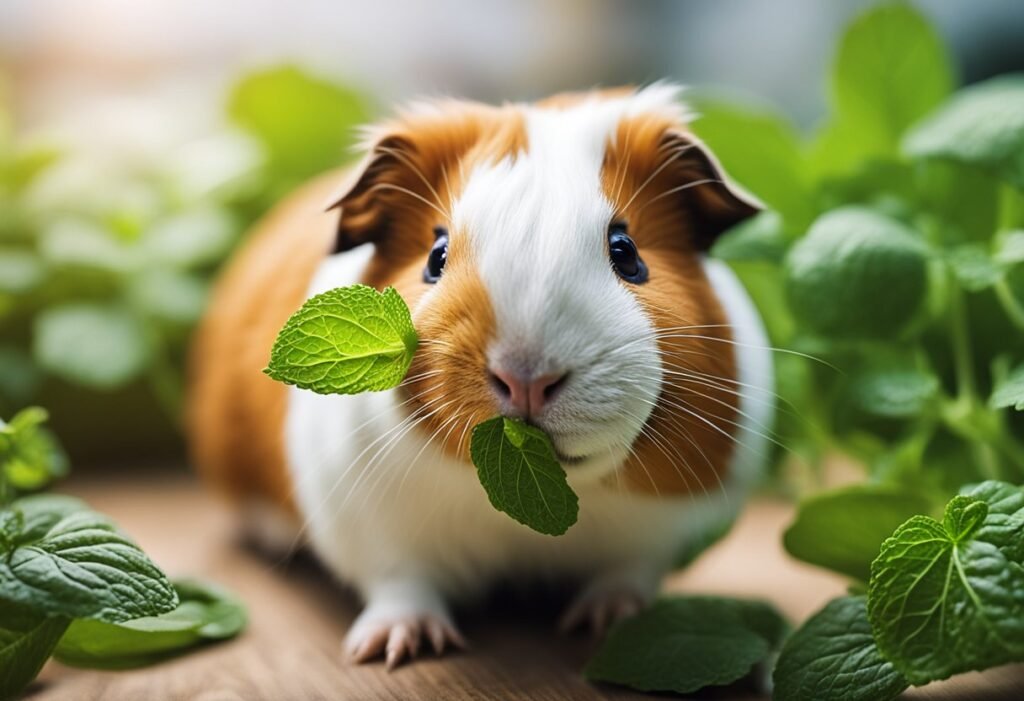
Mint leaves are a flavorful addition to any guinea pig’s diet. Not only do they add variety to their meals, but they also provide several health benefits. Below are some of the benefits of feeding mint leaves to your furry friend.
Digestive Health
Mint leaves can help improve digestive health in guinea pigs. They contain essential oils that stimulate the production of digestive enzymes, which aids in the breakdown of food. This can help prevent digestive issues such as bloating, gas, and constipation. Additionally, the fiber in mint leaves helps regulate bowel movements, promoting a healthy digestive system.
Vitamin C Content
Guinea pigs require a diet high in vitamin C, as they cannot produce it on their own. Mint leaves are an excellent source of vitamin C, providing 8mg per 100g serving. This vitamin is essential for guinea pigs as it helps maintain a healthy immune system, promotes wound healing, and aids in the absorption of iron.
Dental Health
Mint leaves can also benefit guinea pig’s dental health. Chewing on mint leaves can help wear down their constantly growing teeth, preventing them from becoming overgrown and causing dental problems. Additionally, the antibacterial properties in mint leaves can help prevent the buildup of harmful bacteria in their mouth, reducing the risk of dental infections.
In summary, feeding mint leaves to your guinea pig can provide several health benefits. However, it’s important to remember that mint leaves should be fed in moderation, as too much can cause digestive upset. As with any new food, it’s best to introduce mint leaves slowly and monitor your guinea pig’s reaction.
Risks and Considerations
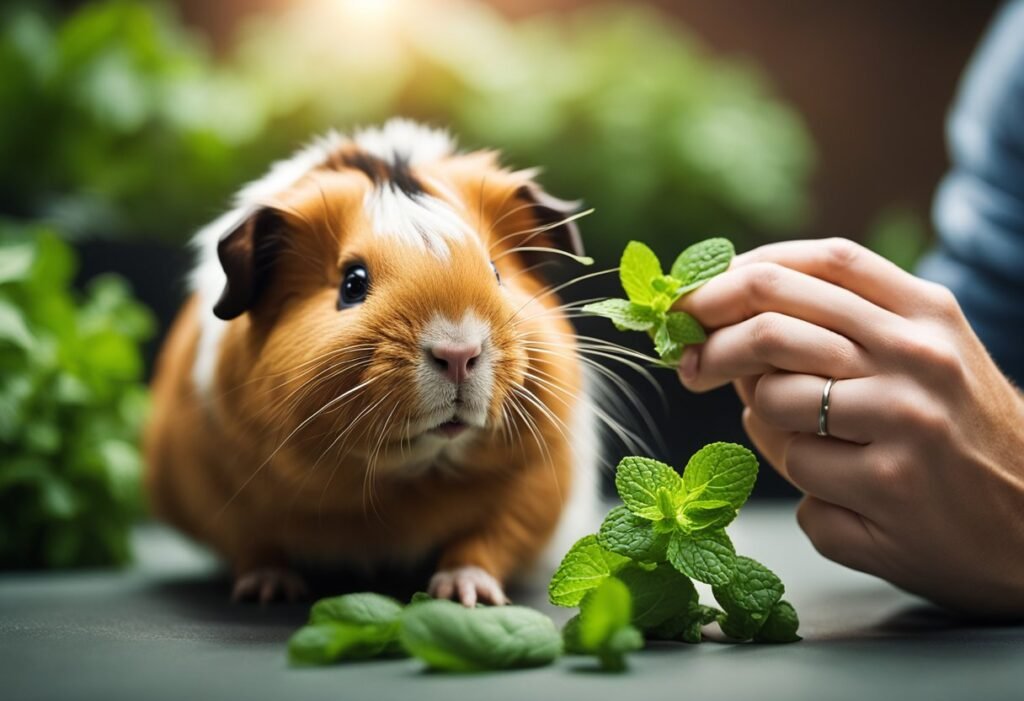
When feeding mint leaves to guinea pigs, there are a few risks and considerations to keep in mind. While mint can be a healthy addition to their diet, it is important to be aware of the potential risks and to feed it in moderation.
Mint as an Occasional Treat
Mint can be a refreshing and tasty treat for guinea pigs, but it should only be given to them in moderation. Too much mint can cause digestive upset and diarrhea, which can lead to dehydration and other health issues. We recommend giving mint leaves to your guinea pig as an occasional treat, rather than a regular part of their diet.
Potential Allergic Reactions
Some guinea pigs may be allergic to mint, so it is important to monitor your pet for any signs of an allergic reaction. Symptoms of an allergic reaction may include itching, swelling, and difficulty breathing. If you notice any of these symptoms, stop feeding mint to your guinea pig immediately and consult with your veterinarian.
Toxicity Concerns
While mint is generally safe for guinea pigs to eat, there are some concerns about the potential for toxicity. Some types of mint, such as pennyroyal, can be toxic to guinea pigs and should be avoided. Additionally, mint plants that have been treated with pesticides or other chemicals can be harmful to guinea pigs. We recommend only feeding your guinea pig fresh, organic mint leaves that have not been treated with any chemicals.
In summary, mint can be a healthy and tasty treat for guinea pigs when fed in moderation and with caution. Be sure to monitor your pet for any signs of an allergic reaction or digestive upset, and only feed fresh, organic mint leaves that have not been treated with any chemicals.
Feeding Guidelines
Portion Control
When feeding mint leaves to guinea pigs, it is important to exercise portion control. Mint leaves are high in calcium and should only be given in small amounts to prevent health issues such as bladder stones. We recommend giving no more than one or two small leaves per guinea pig per day.
Frequency of Feeding
While mint leaves can be a tasty treat for guinea pigs, they should not be fed too frequently. We suggest limiting the frequency of feeding mint leaves to once or twice a week. This will help ensure that guinea pigs receive a balanced and varied diet.
Preparation and Serving
Before feeding mint leaves to guinea pigs, it is important to wash them thoroughly to remove any dirt or pesticides. We recommend serving the leaves in small pieces to make them easier for guinea pigs to eat. It is also important to remove any stems or tough parts of the leaves to prevent choking.
In conclusion, mint leaves can be a safe and enjoyable treat for guinea pigs when fed in moderation. By following these feeding guidelines, guinea pig owners can ensure that their pets receive a healthy and balanced diet.
Alternative Safe Herbs for Guinea Pigs
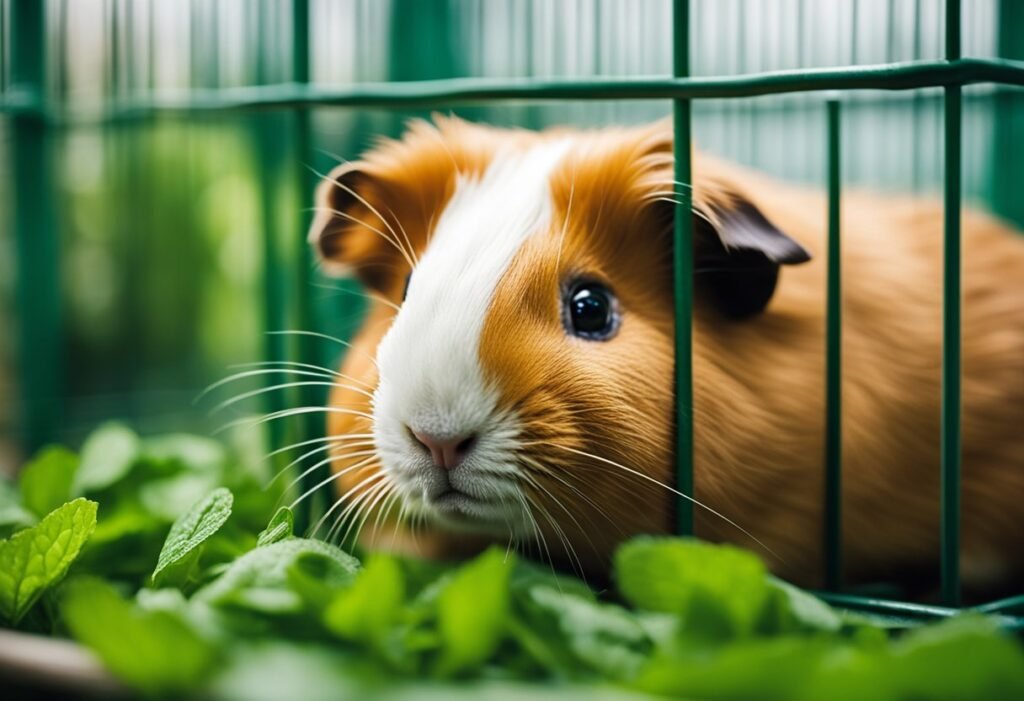
As we know, guinea pigs love to munch on fresh herbs, but not all herbs are safe for them to eat. While mint leaves are safe for guinea pigs in moderation, it’s always good to have a variety of herbs to offer them. Here are some alternative safe herbs that you can give to your guinea pig:
Parsley
Parsley is a great herb to offer your guinea pig as it’s high in vitamin C, which is essential for their health. It’s also a good source of vitamin K, vitamin A, and folate. You can give parsley to your guinea pig as a treat or mix it in with their regular food.
Basil
Basil is another safe herb for guinea pigs. It’s rich in antioxidants and has anti-inflammatory properties. It’s also a good source of vitamin A, vitamin K, and vitamin C. You can offer basil to your guinea pig as a treat or mix it in with their regular food.
Cilantro
Cilantro is a safe herb for guinea pigs and is high in vitamin C, vitamin A, and vitamin K. It also has anti-inflammatory properties and is a good source of antioxidants. You can offer cilantro to your guinea pig as a treat or mix it in with their regular food.
Rosemary
Rosemary is safe for guinea pigs and has anti-inflammatory properties. It’s also a good source of antioxidants and has a pleasant scent. You can offer rosemary to your guinea pig as a treat or mix it in with their regular food.
Thyme
Thyme is a safe herb for guinea pigs and has anti-inflammatory properties. It’s also a good source of antioxidants and has a pleasant scent. You can offer thyme to your guinea pig as a treat or mix it in with their regular food.
In conclusion, while mint leaves are safe for guinea pigs, it’s always good to have a variety of herbs to offer them. The herbs mentioned above are safe and healthy for guinea pigs and can be a great addition to their diet.
Frequently Asked Questions
Is it safe for guinea pigs to consume mint stalks?
Yes, guinea pigs can safely consume mint stalks. However, it is important to note that mint should be given in moderation as it can cause digestive issues if consumed in excess.
What types of herbs are beneficial for guinea pig diets?
Herbs such as parsley, cilantro, basil, and dill are all beneficial for guinea pig diets. These herbs provide essential vitamins and minerals that are necessary for their overall health.
Are there any toxic leaves that guinea pigs should avoid?
Yes, there are several toxic leaves that guinea pigs should avoid. These include avocado, rhubarb, tomato leaves, and potato leaves. These leaves can cause digestive issues and even be fatal in some cases.
Can guinea pigs have parsley as part of their daily diet?
Yes, parsley can be included as part of a guinea pig’s daily diet. It is a good source of vitamin C and other essential nutrients. However, it is important to give parsley in moderation as it can cause digestive issues if consumed in excess.
Are mint flowers an acceptable treat for guinea pigs?
Yes, mint flowers can be given to guinea pigs as a treat. However, it is important to remember that treats should only make up a small portion of their diet and should be given in moderation.
Which common herbs should not be fed to guinea pigs?
Common herbs that should not be fed to guinea pigs include chives, onion, and garlic. These herbs can cause digestive issues and even be toxic in some cases. It is important to avoid feeding these herbs to your guinea pigs.





